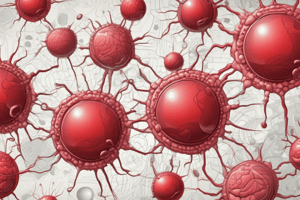Podcast
Questions and Answers
Which of the following are types of granulocytes? (Select all that apply)
Which of the following are types of granulocytes? (Select all that apply)
- Monocytes
- Eosinophils (correct)
- Lymphocytes
- Neutrophils (correct)
- Basophils (correct)
White blood cells (WBCs) do not contain a nucleus.
White blood cells (WBCs) do not contain a nucleus.
False (B)
How long do red blood cells live?
How long do red blood cells live?
120 days
Dead RBCs are removed and destroyed by fixed phagocytic macrophages in the ______ and ______.
Dead RBCs are removed and destroyed by fixed phagocytic macrophages in the ______ and ______.
Which type of white blood cell can be subdivided into T cells, B cells, and NK cells?
Which type of white blood cell can be subdivided into T cells, B cells, and NK cells?
Match the following WBC types with their percentage in total WBC count:
Match the following WBC types with their percentage in total WBC count:
Flashcards are hidden until you start studying
Study Notes
Normal Blood Cells
- A microscopic image shows normal blood cells.
Life Span
- Red blood cells (RBCs) have a life span of approximately 120 days.
- After 120 days, RBCs are removed from blood and destroyed by fixed phagocytic macrophages in the spleen and liver.
- Breakdown products, including heme and proteins, are recycled.
White Blood Cells (WBCs) or Leukocytes
- WBCs have a nucleus but do not contain hemoglobin (Hb).
- The total count of WBCs is between 4000-11000/mm3.
- WBCs are divided into two categories:
- Granulocytes, which contain granules in their cytoplasm:
- Neutrophils (60-70%)
- Eosinophils (2-4%)
- Basophils (1%)
- Non-granulocytes, which do not contain granules:
- Lymphocytes (20-25%)
- Monocytes (3-8%)
Leukocytes Classification
- WBCs are classified into two categories:
- Agranular:
- Lymphocytes (20-25%):
- T cells
- B cells
- NK cells
- Monocytes (3-8%)
- Lymphocytes (20-25%):
- Granular:
- Basophils (0.5-1%)
- Neutrophils (60-70%)
- Eosinophils (2-4%)
Studying That Suits You
Use AI to generate personalized quizzes and flashcards to suit your learning preferences.




